Greatest Hits: Sugar Ray Leonard
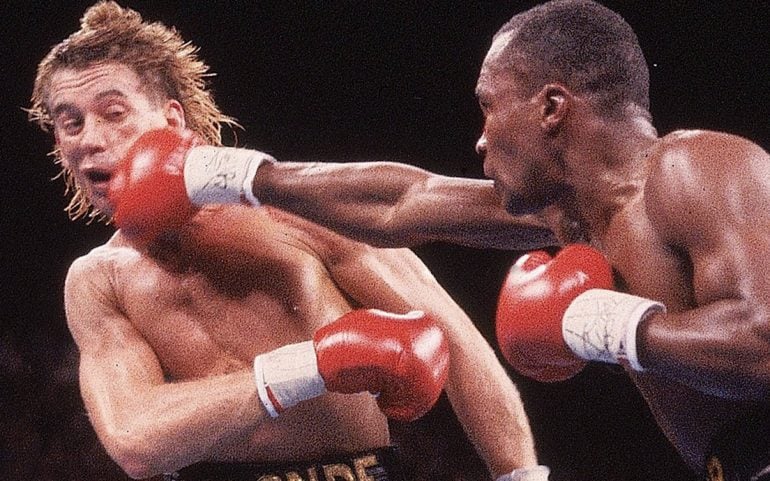
Editor’s Note: This feature originally appeared in the April 2022 issue of The Ring, which is available for purchase at The Ring Shop.
THE DARLING OF THE 1976 OLYMPICS EVOLVED INTO THE TRANSCENDENT SUPERSTAR OF THE EIGHTIES THROUGH FIERCE RIVALRIES AND MEGA-SHOWDOWNS WITH FELLOW ALL-TIME GREATS
Sugar Ray Leonard became a household name when he won gold at the 1976 Olympic Games in Montreal. His fast-tracked professional career only added to his fame and legend, as Leonard would go on to win world titles in five weight classes during the 1980s. Despite inactivity during the mid-’80s and only competing in 40 pro bouts, he is universally revered as one of the all-time greats.
Leonard was born in the coastal city of Wilmington, South Carolina, the fifth of seven children, on May 17, 1956. His family moved to the nation’s capital when he was young before settling in Palmer Park, Maryland. Leonard followed his older brother Roger to the Palmer Park Recreation Center and soon after took up boxing.
“I love challenges. That’s what makes me tick.”
Early into his career, he was validated by the ultimate pound-for-pound king, “Sugar Ray” Robinson.
“I walked up to him and I said, ‘Mr. Robinson, is it OK, because I’ve been using your name?’” Leonard told The Ring. “He said, ‘Absolutely. I’m proud. Thank you so much.’”
Leonard failed to make the 1972 Olympic team, lying about his age (he claimed he was 17 when he was 16) to compete in the Eastern Trials, but he came back more experienced and stronger to become a U.S. representative at the 1976 games. It was a moment that would forever change his life.
ANDRES ALDAMA
July 31, 1976, Maurice Richard Arena, Montreal • Titles: Olympic gold medal, 141-pound division
“It wasn’t about money or fame or anything; it was about representing myself and my country on the highest stage possible. This is global. Nothing is better than the Olympics. The Olympics is by itself; it stands alone as far as reputation, competition, value. People can say they were a world champion, but very few can say, ‘I was an Olympic gold medalist.’
“I felt so confident, but the Cubans were so dominant. I recall I was in this room and I was watching the previous fights, and they’d say, ‘That’s Ray Leonard. He’s fighting that Cuban guy. He’s going to get knocked out.’ I heard that, but they didn’t know I was there.
“What people don’t know and realize, when I stood on that podium with the gold medal draped around my neck, the national anthem being played, I had so many mixed feelings, firstly because I was so happy. I won the gold medal, but I thought it would be my last fight, because I had no intentions of becoming a professional fighter. I’d heard so many horrible stories about that. I had a scholarship to the University of Maryland; I was going to go to college, further my education, get a great job and life goes on. But boxing was saying, ‘No, you’ve got to go this way; this is your road.’ So it was inevitable I became a professional fighter. It was meant to be that I became a professional fighter and a champion. When I think of that, it almost brings tears to my eyes, because at that precise moment standing on that podium, this was it. But no, I was kind of confused, a lot of emotions. I just didn’t know where I was going.”
Result: Leonard UD
Whatever Leonard imagined for himself in that moment, a star had been born. He turned professional amid considerable fanfare with a six-round unanimous decision over journeyman Luis Vega in front of a crowd of more than 10,000 in February 1977.
From that launchpad, the burgeoning superstar became a headliner in the D.C. area and stayed active on the undercards of events like future opponent Marvin Hagler vs. Roy Jones and the heavyweight eliminator between Ken Norton and Jimmy Young.
After 18 months, Leonard was already fighting 10-round fights, handling veterans such as Rafael Rodriguez (UD 10), and fellow up-and-comers Dick Eklund (UD 10) and Floyd Mayweather Sr. (TKO 10). There was an air of confidence about him and the way he took care of business that screamed star power.
Leonard continued to move through the ranks by impressively beating the likes of perennial contender Randy Shields (UD 10), four-time world title challenger Armando Muniz (TKO 6) and seasoned campaigner Pete Ranzany (TKO 4).
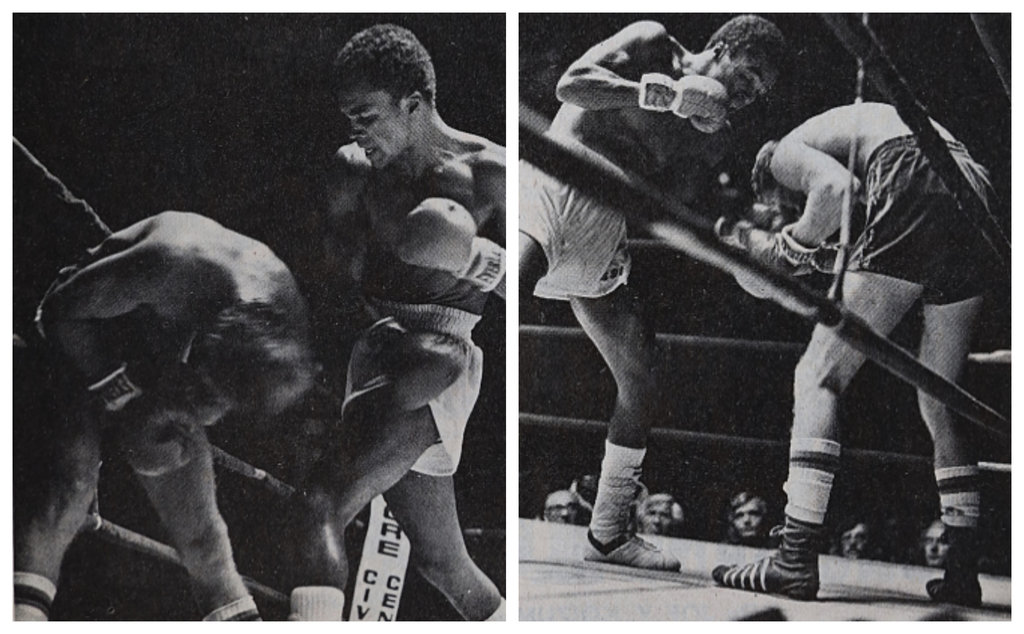
Leonard vs. Shields
Leonard was blessed with many gifts inside the ring: exceptionally fast hands, clever footwork, ring smarts and underrated power. However, we didn’t get to see the other side of what makes a fighter: the intangibles – the things that you have to show when you face a fighter just as talented as yourself. The opportunity to demonstrate that came when he met Puerto Rican phenom Wilfred Benitez in November 1979. Leonard had to fight through and past the limits, showing he had the heart of a champion in claiming the WBC welterweight title.
It proved to be just the beginning. After a routine win over Dave “Boy” Green, Leonard again showed his mettle in a shootout with bitter rival Roberto Duran. Fighting the fierce Panamanian at his own game proved foolhardy and resulted in Sugar Ray’s first loss, but it again emphasized that he had incredible substance behind his considerable skill set. The direct rematch was further testament, as Leonard completely rethought his approach and boxed Duran en route to the incumbent titleholder’s now-famous surrender.
Not one to rest on his laurels, Leonard took a stay-busy fight up at junior middleweight, claiming the WBA and Ring Magazine 154-pound titles against underrated Ayub Kalule.
Leonard promptly dropped back to welterweight and met rival champion Thomas Hearns.
Main Events’ Kathy Duva, who promoted the fight alongside her late husband, Dan, vividly recalls the superfight that more than lived up to its considerable billing and proved to be one for the ages.
 “It was the fight everybody was waiting for,” said Duva. “It was the perfect scenario for a fight. The matinee idol with the gold medal, Ray Leonard, against Tommy from Detroit, the big puncher. It had a little bit of everything.
“It was the fight everybody was waiting for,” said Duva. “It was the perfect scenario for a fight. The matinee idol with the gold medal, Ray Leonard, against Tommy from Detroit, the big puncher. It had a little bit of everything.
“I remember Ray’s eyes, like two coals burning, as he looked across the ring at Tommy.
“They had this amazing fight where it looked for all the world like Tommy was going to win, and Ray, every round, started trying something different until he hit on what worked.”
After a well-deserved victory lap, Leonard took out Bruce Finch in three rounds and was due to face Roger Stafford, but his plans were derailed by a partially detached retina in his left eye, which led to a stunning retirement. From there, Leonard fell into a party lifestyle that revolved around alcohol and cocaine.
Sugar Ray’s life needed boxing, and he returned after a 27-month absence against fringe contender Kevin Howard. Although Leonard ultimately stopped Howard in nine rounds, he suffered the ignominy of a fourth-round trip to the canvas and was disappointed with his performance. He retired a second time but still worked as a color commentator for HBO.
The lure of a matchup with Hagler proved too much, though, and Leonard came back to face the long-reigning middleweight king in April 1987. Leonard sensationally upset Hagler, using all his tactical sense to eke out a split decision and become a three-weight champion.
While most would be more than content with that, Leonard moved up again to defeat the much bigger Donny Lalonde in a fight for super middleweight and light heavyweight titles.
“I love challenges,” Leonard admitted. “That’s what makes me tick. That’s what makes me who I am against these incredible, great champions.”
He fought former adversaries Hearns (D 12) and Duran (UD 12) in 1989. Both fights did robust business and garnered massive paydays, making Leonard the first boxer to earn more than $100 million during his career, but he showed signs of slowing down in the ring. He suffered two knockdowns against Hearns in their long-awaited rematch, and although he clearly outpointed Duran in their rubber match, he incurred 60 stitches’ worth of facial cuts from his archrival’s head and fists late in the bout. Leonard retired soon after the Duran bout. However, the king of comebacks would make two more ill-advised returns against Terry Norris (L UD 12) in 1991 and Hector Camacho Sr. (L TKO 5) in 1997 before bowing out for good.
A fit and spry 65, Leonard enjoys tennis and spending time with his family. He also dedicates his energy to the Sugar Ray Leonard Foundation, which supports research for diabetes.
“My father was diabetic,” he said. “Every May, we do a boxing event with Golden Boy Promotions. We’ve raised well over three-and-a-half million dollars.
“Life is what you make it. I can’t complain, because where I am, what I’ve achieved, I try to give back, especially to this sport. If it wasn’t for boxing, I wouldn’t be here now. I made an impact in the ring; I just want to make a larger impact outside the ring, helping people.”
Here’s what he had to say about his most memorable nights in the ring:

Sugar Ray Leonard was ready for Wilfred Benitez because of his tough, busy schedule as he rapidly climbed the welterweight rankings. Photo / Ring Magazine
WILFRED BENITEZ
November 30, 1979, Caesars Palace, Las Vegas • Titles: Ring and WBC welterweight
“I loved the challenge. I loved being the underdog. And when I walk to the ring, I don’t think about losing whatsoever; I just think of what needs to be carried out – tunnel vision. That’s believing in yourself. Because if you don’t, nobody else will. And that’s what I had over some of the guys.
“I love it when there’s tons of people, fans, when it’s a big fight, incredible opponent. Wilfred Benitez was an amazing young champion, far more experienced than me, so much talent – a natural talent. You can’t teach some of the things he had. He was like a radar. He was amazing. Going 15 rounds, that was one of the biggest challenges.
“It was a chess match. He was surprised – I saw it in his eyes – at my speed, and then he had speed. I was naturally a better puncher than he was. He was very elusive; he seemed like he was right there in front of me – I never missed so many punches in a ring like I did with him. That championship fight, when I won, it was the biggest gift I ever thought I would receive. I went back to my hotel, I was so dehydrated. After 10, 12 rounds, I was exhausted; I fought him just with heart. I could be exhausted, but if I rock you, I normally finish the job, because I’m [overflowing] with intestinal fortitude. It’s something inside all of us, but we can’t all activate it, and that’s how I got rid of him in the 15th. I knocked him down one time and I never let up. He doesn’t get credit for it, but he was one of my toughest fights.
“I just went to my hotel and went to bed. I was so happy, elated, so proud, but when you’ve just faced one of the all-time greats … Although he’s not given the total respect he deserves, I still would rate him as one of the greatest fighters, too.”
Result: Leonard TKO 15

Duran and Leonard in their thriller from June 1980. Photo by Focus on Sport/ Getty Images
ROBERTO DURAN I
June 20, 1980, Olympic Stadium, Montreal • Titles: Ring and WBC welterweight
“That was more than a big fight; it was going to make me who I wanted to be. I can smell his breath now; I go so deep.
“I won the gold medal in Montreal, and when I walked to the ring I heard some boos – that on top of Roberto Duran, he would say some foul things to me, gave me some hand gestures, gave my wife hand gestures. I was angry. He got under my skin and I wanted to beat him at his own game. I didn’t realize that was not a smart move until the middle-to-late rounds.
“Roberto Duran was my teacher; he was the guy who was going to show me to fight the right way, not to lose your temper, not to get mad, not get angry but stay composed. I paid for it.
“Even then I considered retiring, because the punches he hit and landed were so painful. ‘Manos De Piedra,’ no question; he was that. He hit me so many places, I was looking around saying, ‘Who else is in the ring with us?’ He never let up. It was like perpetual motion. He was all over the place.
“I figured I’m too big for this guy; that was not the case in there. This is what he did to me: He got inside my head, he hit me with body shots – I’ve never been hurt by body shots, but it rocked me. I looked at his eyes; they were dark and they were deadly, no tomorrow for him. I never saw anyone with so much intensity.”
Result: Duran UD 15
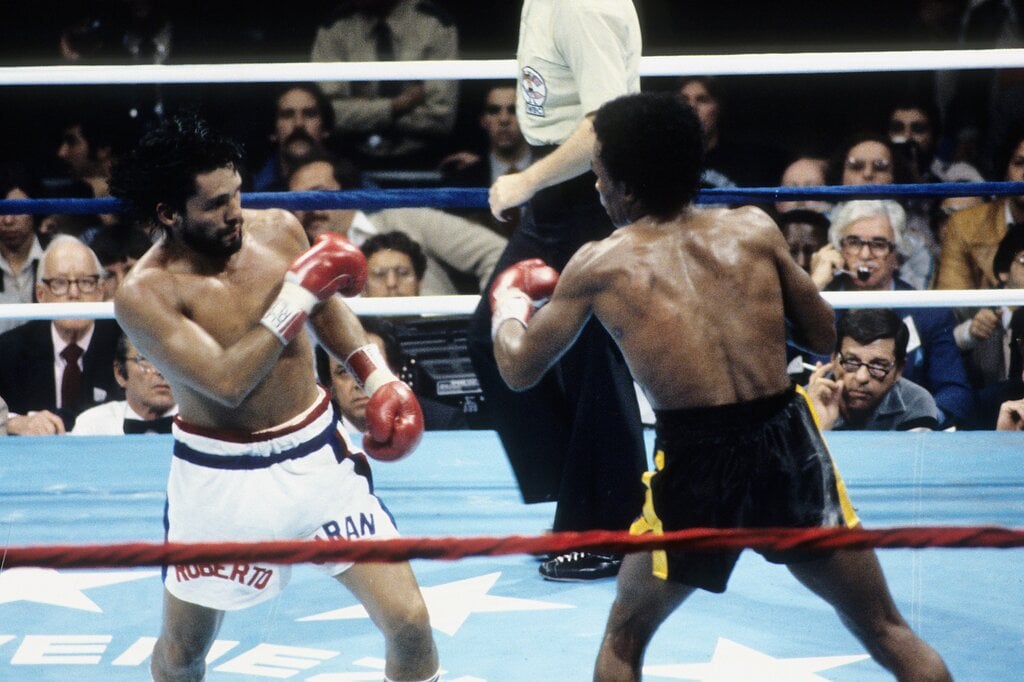
Leonard’s jab gave Duran a nightmare. Photo from The Ring archive
ROBERTO DURAN II
November 25, 1980, Superdome, New Orleans • Titles: Ring and WBC welterweight
“I took my wife – she fainted at ringside when [Duran] got the decision – to Hawaii to just get away. No more boxing.
“The next morning, I’m running on the beach and I’m hearing people say, ‘Ray, you could beat Duran if you boxed him. You shouldn’t have stood toe-to-toe.’ Like I don’t know this. So I called my business partner, Mike Trainer. I said, ‘Mike, I want to fight Duran in a rematch,’ and he said, ‘Ray, aren’t you on vacation with your wife?’ I said, ‘Yeah.’ He said, ‘We can talk when you get home.’ I said, ‘No, I want to fight him.’ Total different mindset.
“I knew I could do better. That takes a lot of understanding what you’ve been through. I’d felt the punches of – my friend now – Roberto. They say life is what you make of it. It’s true. The fight game is what you make of it.
“He had his lifestyle. I had something of a lifestyle but did things more in moderation, to my knowledge. If I had waited a year or two, he would still be in my head.
“If I do things my way – boxing, counterpunching, use my hand speed – nine times out of 10, I’m going to beat you. That’s what I did in the second fight. I stepped up to the plate. I experienced it, so I know what takes place. You have to be 100 percent.
“Timing is important in every aspect of life, and boxing too. My trainer, Angelo Dundee, said he wanted to make sure I peaked at fight night. That was so important. I was so ready; my weight was OK. This particular fight, there was no B.S. in my training camp; everything was serious. I’d train, go back to my room and watch that fight again, which was tough to watch me get beat up. But that is what was required for me to know exactly what he could do, which was a lot, and what I could do, which was a lot. But if I did it my way, I can beat him.
“I didn’t hear him say, ‘No mas.’ He did this. (waves his hands) Duran is a sweetheart now but was a bully in the ring, which was a plus. When I did things and made people laugh, that’s when it gets into your head and mentally broke him. If someone was hitting me and people were laughing, it would dilute my confidence, and everything is in the mind and heart for the most part.”
Result: Leonard TKO 8
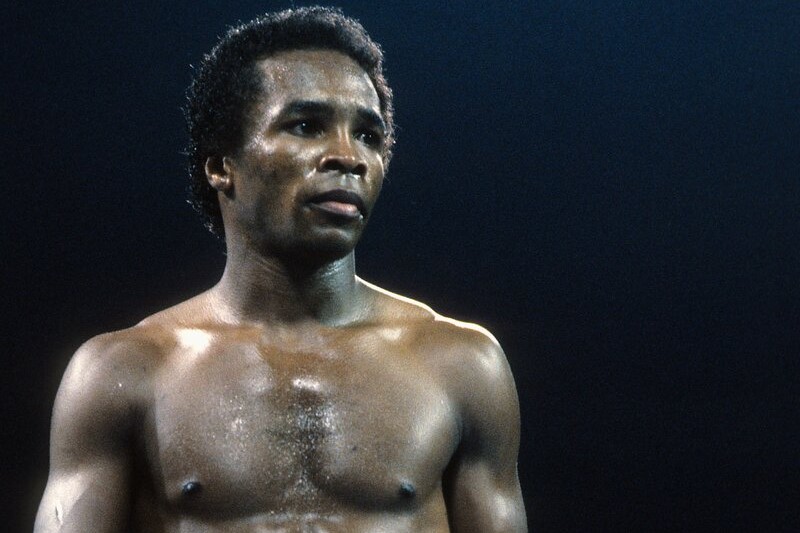
Photo by The Ring/ Getty Images
AYUB KALULE
June 25, 1981, Astrodome, Houston • Titles: Ring and WBA junior middleweight
“Kalule was tough, very tough. Kalule was so awkward and dedicated and determined. He was a little taller than me and he was a southpaw.
“I do remember I wasn’t pumped up for him because he didn’t have the big name. But what took place in the ring that night, I was 100 percent in shape, but I didn’t have that additional aggression. He growled at me and for some reason it upset me, but it brought me to that zone and level of mindset. I said, ‘I’m going to get you for that.’ I used that growl to be more aggressive.
“When everyone says, ‘You’re going to win the fight,’ it takes something away, because I was supposed to win. Then it goes through your mind and you take them for granted. That’s what I learned not to do. I take everyone like they’re King Kong.”
Result: Leonard TKO 9

Hearns’ huge advantages in height and reach kept Leonard from getting off for long periods. (Photo by Dirck Halstead/Liaison)
THOMAS HEARNS
September 16, 1981, Caesars Palace, Las Vegas • Titles: Ring, WBA and WBC welterweight
“I’d heard of Tommy Hearns. Then I got to know Tommy Hearns, because I would go and see some of his fights and would do some of the color commentary with HBO. He was a beast in that ring, a freak of nature in the ring at 147 – long arms, fast, big-time heart, almost too big.
“I had a black eye [in training camp]; his jab [made the injury worse]. It was tough to get close to him because he was so fast, powerful and accurate. In the middle-to-late rounds, Angelo Dundee said, ‘You’re blowing it.’ Fighters know when we’re losing, so I knew Tommy was winning, but to hear Angelo Dundee say it that way, with that tone … He wasn’t angry. Angelo Dundee kept his composure. He wasn’t freaked out that I was on the losing end of that fight.
“[Hearns] was boxing, slipping and sliding. I said, ‘I’ve never seen Tommy do this.’ Because he normally knocks everyone out. I threw bodyshots, and when I did hurt Tommy, that’s what I can do. When I’m exhausted, I can close the show. That’s when that intestinal fortitude comes into play – I want it more than you do. It’s hard to articulate, but all great, legendary fighters have that moment when they look and nothing else exists. That’s something you can’t teach. Tommy made me who I am. Duran made me who I am. Hagler … go down the line. Same thing with them. We brought the best out of each other.”
Result: Leonard TKO 14
READ “A fan remembers Leonard vs. Hearns” by Lee Groves
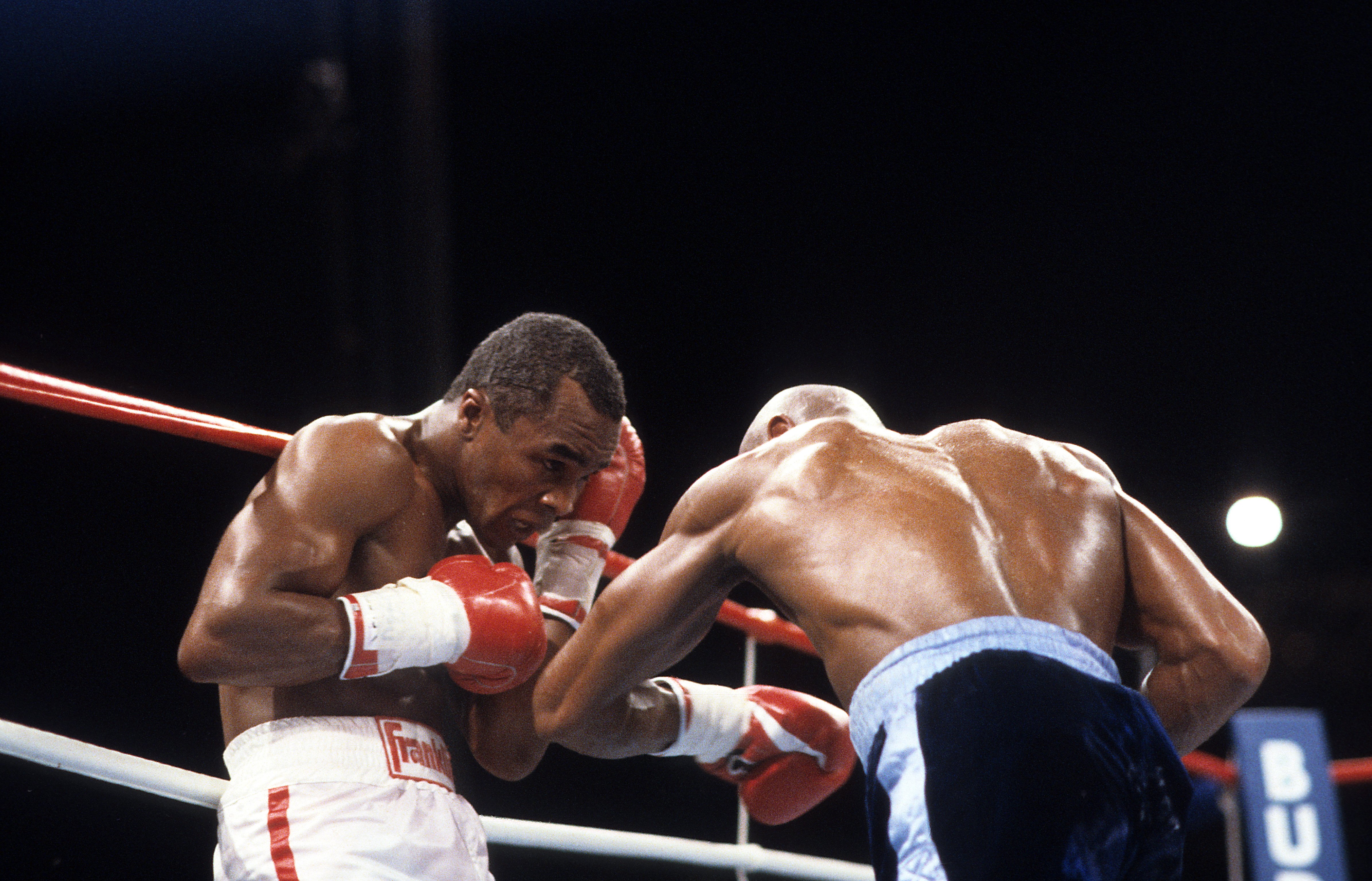
Leonard (left) in battle against Marvelous Marvin Hagler. Photo from The Ring archive
MARVIN HAGLER
April 6, 1987, Caesars Palace, Las Vegas • Titles: Ring and WBC middleweight
“To me, Marvin Hagler was one of the greatest, if not the greatest middleweight champion – respected, loved, admired, tons of fans. I never thought it would happen, because of my eye injury. It had been three, four, five years I’d been out of the ring.
“It was Roberto Duran; I was doing commentary on his fight with Hagler [in November 1983]. I didn’t think Duran could go the distance, but he showed me something. He walked over to me and said, ‘Ray, you box him, you beat him.’ During that time, I was out drinking, cocaine, everything bad for you. I thought about it, but it didn’t resonate. It didn’t seem that important. I was OK, but every month, every year it would pull me and I would soften those blows with alcohol and cocaine.
“I saw something [when Hagler fought John Mugabi in March 1986]. I said, ‘I can beat that guy. I can beat him.’ After that fight, I called my friends, business partners, my brothers, and they said, ‘I understand you’re considering fighting Hagler?’ I said, ‘Yeah.’ My brother Roger said, ‘Who’s your tune-up?’ I said, ‘Hagler.’ He said, ‘No, who’s your tune-up before the fight?’ I said, ‘He is, because he’s going to motivate me.’ Even my brothers didn’t understand, it’s hard for me to get up where I am today. I told my father-in-law, I said, ‘I’m going to fight Marvin Hagler.’ He said, ‘Ray, excuse me? You can’t do that. Hagler’s going to kill you.’ But that’s what motivates me.
“People cared about me. My family cared about me. When they said detached retina, they said, ‘You can go blind.’ Everything is possible, but I didn’t think about the eye, because I had one of the best ophthalmologists. When he did the surgery, he said, ‘If you want to go back in the ring, you can, because now your left eye is stronger than the right eye.’
“I know with Hagler, it was like me with other fighters. They said, ‘Ray, you can beat him. He doesn’t have a chance.’ You have to believe in yourself, because if you don’t, no one else will. When I’m in that ring, when I have tunnel vision, I know I’m going to win the fight. I know right away. I know within a minute of getting in the ring I’m going to win, because I’m confident. I’m 100 percent in shape, no shortcuts. I knew that night.
“My training camp was impeccable, no B.S. I used to have friends over, just people in general my brothers and sisters would bring; the entourage would be so much. For Hagler, I said, ‘No, no one’s coming here.’ Preparing for the Hagler fight, I worked out for over a year. I had to get used to getting hit again. When you’re out the ring for beyond a year – two, three years – this is not real. I worked on that. My sparring partners used 8-, 10-ounce gloves; I used 14-ounce gloves. I want to get that feeling in. It sounds crazy, but it worked. I could withstand his punches.
“It was a statement. I said, ‘I’m a winner either way, because I went the distance with Marvin Hagler.’ Two things happened: Someone walked up to me [at the end of the fight before the scorecards were read] and said, ‘You won the fight.’ I said, ‘What? OK.’ Then when Hagler did a little dance, that was uncharacteristic; Hagler doesn’t do that. I understand that fighters know when we lost, when it’s too close for comfort. Most fighters won’t say it. Bravado. I always felt I won. (laughs) I threw a lot of shots before the bell would ring. I had my guy yell out from camp, ‘30 seconds, Ray.’ I would throw punches and catch the judges and everyone else’s eye – they are landing, the last thing that happened [in the round].”
Result: Leonard SD 12
READ “Sugar Ray Leonard: ‘If my win over Marvin Hagler could be reversed to bring him back, I would give it away'”
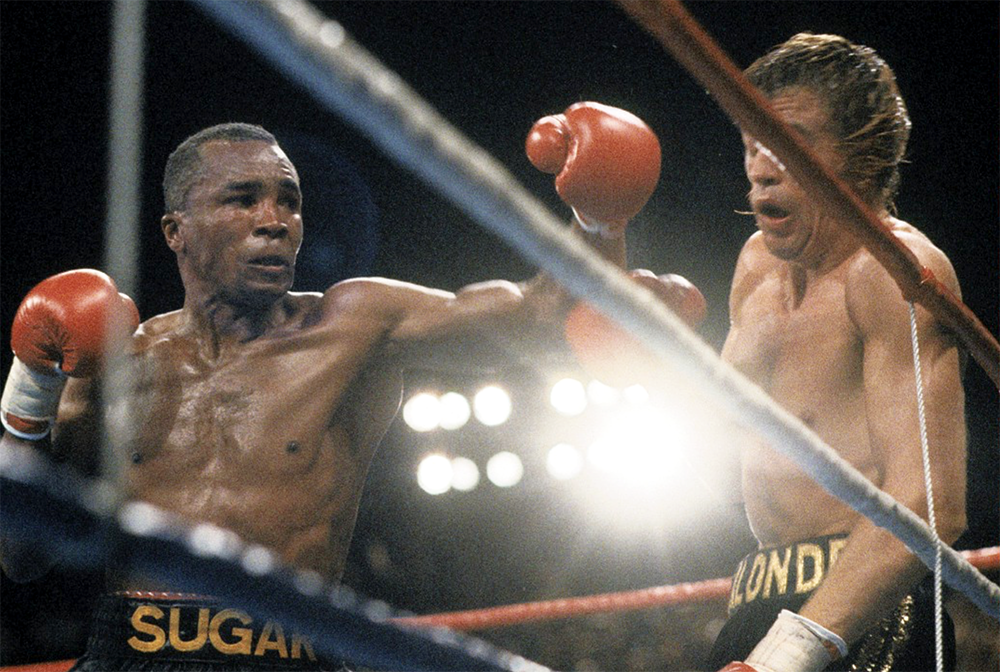
Even when Leonard (pictured here against Donny Lalonde) was past his prime and competing in heavier weight classes, he still exhibited a fierce killer instinct after hurting his opponent.
DONNY LALONDE
November 7, 1988, Caesars Palace, Las Vegas • Titles: WBC super middleweight and WBC light heavyweight
“He hit me so hard. His big punches, the right hand, hurt me and had me on the level of being stopped, but I had so much heart, drive, desire.
“I told Donny this; I said, ‘When you knocked me down, I heard someone say in the audience, ‘Take out that N-guy.’’ That fan helped me; he won me the fight. I don’t hear that ever. When I heard that, I was down and almost … not giving up, but it’s not there anymore. But that reversed everything in my head, and … hell, no. And I got up. I told Donny, ‘You should get that guy and punch him out. (laughs) I know it’s not real, but it was real. I got up and went crazy because I had that thing that not a lot of fighters have, that you can rectify and come back like a true champion, true warrior.
“I relinquished that crown so fast. When I weighed in, I had silver dollars in my pocket to weigh a little more.”
Result: Leonard TKO 9
READ “Best I Faced: Sugar Ray Leonard” (August 2017)
Questions and/or comments can be sent to Anson at [email protected] and you can follow him on Twitter @AnsonWainwright.
















